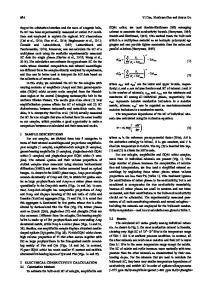Improvements in the Conductivity of n-type ZnO Through Codoping with Al and In
- PDF / 242,298 Bytes
- 6 Pages / 612 x 792 pts (letter) Page_size
- 21 Downloads / 328 Views
1035-L03-02
Improvements in the Conductivity of n-type ZnO Through Codoping with Al and In S. D. Kirby, and R. B. van Dover Materials Science and Engineering, Cornell Univerity, 214 Bard Hall, Ithaca, NY, 14853 ABSTRACT ZnO has been identified as a viable candidate to replace expensive Sn doped In2O3 due to its high transparency and good conductivity. ZnO has been doped with many elements including Al and In to achieve conductivities near 104 Ω-1cm-1. One of the limiting factors in improving the conductivity beyond this is the limited solubility of these dopants in ZnO. The effect of codoping ZnO with both Al and In has been studied using a combinatorial technique. Cosputtering from three elemental targets in the presence of oxygen allowed for a range of ZnO(Al, In) compositions to be deposited on a single substrate. A deposition temperature of 250°C was used. The films were analyzed using x-ray diffraction, electron microprobe, four-point resistivity measurements, Hall measurements, and reflection and transmission spectroscopy at optical wavelengths. Films that were codoped with both Al and In were found to have a significantly improved conductivity compared to singly doped samples, resulting mainly from an increase in mobility. This has been attributed to improved atomic structure of the codoped film. Al3+ has an ionic radius smaller than that of Zn2+ while In3+ has a larger radius; it is speculated that codoping compensates for these differences, reducing stress fields. The lattice parameter of the codoped film reflects this compensation effect. INTRODUCTION ZnO has received a lot of attention as a possible transparent conductor in many applications due to its good electrical and optical properties and cheap deposition. Currently, it has been doped with a variety of dopants such as indium, gallium and aluminum. The conductivity of the film is limited by the solubility of the dopant in ZnO. Furthermore, as dopant level increases, the mobility decreases due to increased intragrain scattering (charged-impurity scattering as well as disruption of the lattice by strain) as well increased intergrain scattering due to refinement of the grain size and presence of a segregated second phase at grain boundaries, We propose that codoping with more than one dopant can increase the overall dopant solubility without a decrease in mobility. In particular, we have identified indium and aluminum as particularly promising candidate for codoping in ZnO. Indium tends to be incorporated as In3+ which has an ionic radius larger than that of Zn2+. Aluminum tends to be incorporated as Al3+ which has a smaller ionic radius than Zn2+. We therefore expect that codoping with both In3+ and Al3+ will result in size compensation, which could result in smaller stress fields, better crystal quality even at low deposition temperatures and therefore better mobility. Codoping could therefore be very useful for achieving high conductivity ZnO at low processing temperature. The goal of lower processing temperature is especially important for implemen
Data Loading...











